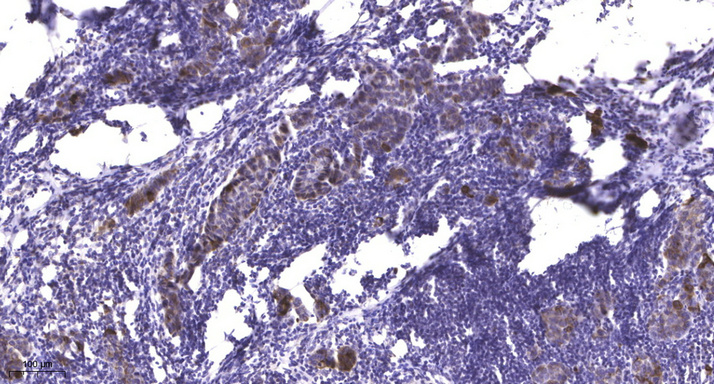Stat5 (Phospho Tyr694) rabbit pAb
- Catalog No.:YP1515
- Applications:WB;IHC
- Reactivity:Human;Mouse
- Target:
- Stat5
- Fields:
- >>ErbB signaling pathway;>>Chemokine signaling pathway;>>Necroptosis;>>JAK-STAT signaling pathway;>>Th1 and Th2 cell differentiation;>>Th17 cell differentiation;>>Prolactin signaling pathway;>>AGE-RAGE signaling pathway in diabetic complications;>>Growth hormone synthesis, secretion and action;>>Hepatitis B;>>Measles;>>Human T-cell leukemia virus 1 infection;>>Pathways in cancer;>>Viral carcinogenesis;>>Chemical carcinogenesis - receptor activation;>>Chronic myeloid leukemia;>>Acute myeloid leukemia;>>Non-small cell lung cancer
- Gene Name:
- STAT5B
- Protein Name:
- Stat5 (Tyr694)
- Human Gene Id:
- 6777
- Human Swiss Prot No:
- P51692
- Mouse Gene Id:
- 20851
- Mouse Swiss Prot No:
- P42232
- Rat Gene Id:
- 25126
- Rat Swiss Prot No:
- P52632
- Immunogen:
- Synthesized phosho peptide around human Stat5 (Tyr694)
- Specificity:
- This antibody detects endogenous levels of Human Mouse Stat5 (phospho-Tyr694)
- Formulation:
- Liquid in PBS containing 50% glycerol, 0.5% BSA and 0.02% sodium azide.
- Source:
- Polyclonal, Rabbit,IgG
- Dilution:
- WB 1:500-2000;IHC 1:50-300
- Purification:
- The antibody was affinity-purified from rabbit serum by affinity-chromatography using specific immunogen.
- Concentration:
- 1 mg/ml
- Storage Stability:
- -15°C to -25°C/1 year(Do not lower than -25°C)
- Other Name:
- Signal transducer and activator of transcription 5B
- Observed Band(KD):
- 90kD
- Background:
- The protein encoded by this gene is a member of the STAT family of transcription factors. In response to cytokines and growth factors, STAT family members are phosphorylated by the receptor associated kinases, and then form homo- or heterodimers that translocate to the cell nucleus where they act as transcription activators. This protein mediates the signal transduction triggered by various cell ligands, such as IL2, IL4, CSF1, and different growth hormones. It has been shown to be involved in diverse biological processes, such as TCR signaling, apoptosis, adult mammary gland development, and sexual dimorphism of liver gene expression. This gene was found to fuse to retinoic acid receptor-alpha (RARA) gene in a small subset of acute promyelocytic leukemias (APLL). The dysregulation of the signaling pathways mediated by this protein may be the cause of the APLL. [provi
- Function:
- disease:Defects in STAT5B are the cause of Laron type dwarfism II (LTD2) [MIM:245590]; also known as Laron syndrome type II or Laron syndrome due to a post-receptor defect. The phenotypic features are consistent with growth hormone deficiency in the presence of normal to elevated circulating concentrations of growth hormone, and resistance to hexogeneous hormone therapy.,function:Carries out a dual function: signal transduction and activation of transcription. Binds to the GAS element and activates PRL-induced transcription.,online information:STAT5 entry,online information:STAT5B mutation db,PTM:Tyrosine phosphorylated.,similarity:Belongs to the transcription factor STAT family.,similarity:Contains 1 SH2 domain.,subcellular location:Translocated into the nucleus in response to phosphorylation.,subunit:Forms a homodimer or a heterodimer with a related family member. Binds NR3C1 (By simil
- Subcellular Location:
- Cytoplasm . Nucleus . Translocated into the nucleus in response to phosphorylation. .
- Expression:
- Brain,Epithelium,Lymph,Placenta,
- June 19-2018
- WESTERN IMMUNOBLOTTING PROTOCOL
- June 19-2018
- IMMUNOHISTOCHEMISTRY-PARAFFIN PROTOCOL
- June 19-2018
- IMMUNOFLUORESCENCE PROTOCOL
- September 08-2020
- FLOW-CYTOMEYRT-PROTOCOL
- May 20-2022
- Cell-Based ELISA│解您多样本WB检测之困扰
- July 13-2018
- CELL-BASED-ELISA-PROTOCOL-FOR-ACETYL-PROTEIN
- July 13-2018
- CELL-BASED-ELISA-PROTOCOL-FOR-PHOSPHO-PROTEIN
- July 13-2018
- Antibody-FAQs
- Products Images

- Immunohistochemical analysis of paraffin-embedded human Breast cancer. 1, Antibody was diluted at 1:200(4° overnight). 2, Tris-EDTA,pH9.0 was used for antigen retrieval. 3,Secondary antibody was diluted at 1:200(room temperature, 45min).



